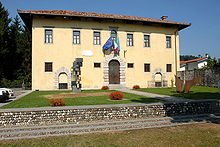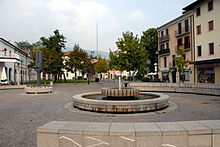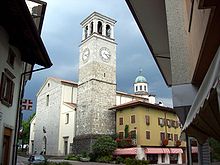Tarcento
| Tarcento | ||
|---|---|---|

|
|
|
| Country | Italy | |
| region | Friuli Venezia Giulia | |
| Coordinates | 46 ° 13 ' N , 13 ° 13' E | |
| height | 230 m slm | |
| surface | 35 km² | |
| Residents | 8,919 (Dec. 31, 2019) | |
| Population density | 255 inhabitants / km² | |
| Post Code | 33017 | |
| prefix | 0432 | |
| ISTAT number | 030116 | |
| Popular name | Tarcentini | |
| Patron saint | San Pietro | |
| Website | www.comune.tarcento.ud.it | |
Tarcento ( Tarcint in Friulian ) is an Italian commune with 8919 inhabitants (as of December 31, 2019) in the Friuli-Venezia Giulia region .
geography
Tarcento is 230 m above sea level, 20 kilometers north of Udine . The town is characterized by an area of rural character in different and contrasting forms: in the north the Julian Prealps, impressive limestone fortifications that barricade the horizon; in the south the wide Friulian plain; to the east the Colli Orientali; to the west the moraine amphitheater of the Tagliamento , the hilly landscape formed after the last ice age .
Districts
Bulfons, Ciseriis, Coia, Collalto, Collerumiz, Loneriacco, Molinis, Sammardenchia, Sedilis, Segnacco, Stella, Zomeais
Neighboring communities
Cassacco , Lusevera , Magnano in Riviera , Montenars , Nimis , Reana del Rojale , Tricesimo
history
The first written names of Tarcento date back to the 12th century, but the city boasts of much older origins: scholars actually speak of Stone Age populations followed by prehistoric settlements, then Celtic ones, and then of course the colonization of the Romans. However, until the first mention of the name can be traced, one must be patient until 1126, when Tarcento was the domain of the Machland , who came from Perg ( Austria ). In 1219 the Machland were replaced by the Kaporiakern. In 1281 the Patriarch of Aquileia Raimondo dalla Torre gave the fief to the noble Artico of Castel Porpetto. Tarcento thus remained under the jurisdiction of the Castel de Porpetto until the time of Napoleon (1797). In 1866 the town was incorporated into the Kingdom of Italy and thus became the district capital. Parts of the place were destroyed by an earthquake on May 6, 1976 and rebuilt in the following years.
Attractions
Villas
The small town on the Torre was called the "Pearl of Friuli" at the beginning of the twentieth century. The mild climate and the beautiful location favored the construction of numerous villas. The architects Ruggero Berlam and his son Arduino Berlam created one of their most beautiful buildings with the Villa Moretti (around 1920). Also noteworthy is the Villa Pontoni , the oldest part of which (“palazzat”), the former main residence of the noble Frangipane family, dates back to the 16th century. Villa Angeli , later owned by the Frangipane and the Prampero, interior decorations by Francesco Barazzutti (19th century); Villa de Rubeis , built in 1759; Villa Marcuzzi (1924) designed by Ermes Midena. Palazzo Frangipane in Villafredda, today in public ownership; the enchanting Villa Liruti set in a medieval fortified complex .
Parish Church of San Pietro
The parish church in the city center dates back to the Romanesque period, but it was rebuilt in the 15th century and later expanded and changed.
In 1813 the high altar was bought from the church of Santa Maria della Cella in Cividale. This imposing work of art made of marble is decorated with beautiful statues from the 16th century. The altarpiece shows the handing over of the keys to Peter and was made by Odorico Politi. It is based on antique models, correctly executed, even if a little theatrical in its representation. Decorations by Francesco Barazzutti adorn the choir. The ceiling in the nave is decorated with frescoes of the Assumption by Giuseppe Ghedina from 1874.
Medieval castle
The upper castle (destroyed in the middle of the 14th century), located on the hill at 410 m above sea level near the village of Spizzot, was much older than the lower castle (14th to 16th centuries) or the Palazzo Frangipane (16th / 17th century). Century). Today there are practically no remnants of the wall left. Only from the lower castle is still the decaying keep as silent witness present. The new Frangipane Castle now functions as the town hall .
Community partnerships
On June 1st, 2008, Tarcento started a partnership with the Upper Bavarian municipality of Unterföhring .
Web links
Individual evidence
- ↑ Statistiche demografiche ISTAT. Monthly population statistics of the Istituto Nazionale di Statistica , as of December 31 of 2019.













